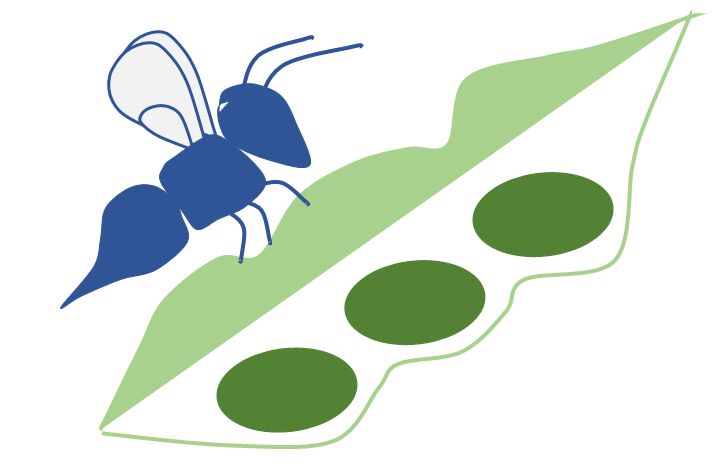Plants protect themselves from attack
Many plants produce chemicals in their leaves, stems, roots or seeds to protect from attack by pests.
Examples many people are aware of could include:
- The coffee plant (Coffea sp.) produces caffeine in its flowers, nectar and berries. Caffeine is a mild drug for humans, but it also tastes bitter and deters insects from eating the coffee plant and causing damage to it.
- The tobacco plant (Nicotiana sp.) produces nicotine in all its plant parts. While nicotine is toxic and addictive to humans, it is also powerfully toxic to many insects, meaning the tobacco plant is protected from attack by pests like caterpillars2.
- Many garden herbs contain essential oil compounds. These smell strong and pleasant to humans and are popular in cooking or even for medicinal purposes. But they often also have important effects on insects: some kill insects and others repel them. This means that the herbs suffer less attack by insects. This is particularly important for herbs that are native to dry regions like the Mediterrean, because the low rainfall means making new leaves takes a lot of the plant's resources...so every leaf is precious!
There are thousands more examples!
People have been using the chemicals in plants for thousands of years
It is well known that many plants have medicinal properties. Most of these are due to the chemicals they produce in order to protect themselves from pests and diseases: the essential oils of lavender and rosemary, for example, are antibacterial so useful to humans in medicine, but also anti-feedant to many insects.
These insecticidal or antifeedant properties can be used in agriculture too.
When a crop is attacked by pest insects such as aphids, whitefly or caterpillars, the "obvious" response to many people may be to spray the field with synthetic pesticides.
However, not everyone can or wishes to apply synthetic pesticides, for a variety of reasons:
- Synthetic pesticides are unaffordable to some farmers in low and middle income countries (LMICs).
- Not all farmers can obtain them whenever they are needed.
- Sometimes pesticide products in LMICs may be adulterated or contaminated.
- The instructions for application may be written in a different language, or damaged - and not all farmers globally are literate.
- Some synthetic pesticides pose risks to human health.
- Some synthetic pesticides have severe negative impacts on biodiversity in and around farms, impacting non-target organisms such as pollinators and natural enemies3.
- Over time, many sythetic pesticides lose effectiveness as insects evolve resistance to them4.
There are other options, however.
Pesticidal plants
The chemicals plants produce to protect themselves can also be used by humans to protect crops from insect pest attack. Either the plant material can be used after no or minimal processing, as a pesticidal plant, or the active ingredients can be extracted and highly processed into a standardised product, often marketed as a "botanical insecticide". Examples of commercial products derived from plants' protective chemistry include Pyrethrum (from Tanacetum cinerariifolium) and Neem (from the neem tree, Azadirachta indica).
Pesticidal plants can be applied either before harvest, in the field, or after harvest to stored products (dried cereals, legumes, etc.).
The advantages of using pesticidal plants vary depending on the location, the product, the cropping system and other factors, but can include:
- Increased affordability relative to synthetic pesticides
- Increased availability to farmers
- Lower toxicity to humans compared to some synthetic products
- Lower toxicity to non-target organisms such as bees (but this is not always the case5)
- Reduced risk of resistance development, as pesticidal plants have a complex chemistry which is harder to evolve resistance to
However, it is important to be mindful of regulatory issues, the fact that "natural" does not automatically equate to "benign", and appropriate use of the material: identification, preparation, application, etc.
The partners in this project have a long history of working on aspects of pesicidal plant research. For more information, go to the ADAPPT and OPTIONS websites.
1Nathanson, J. A. (1984). Caffeine and related methylxanthines: possible naturally occurring pesticides. Science, 226(4671), 184-187.
2Van Dam, N. M., Hadwich, K., & Baldwin, I. T. (2000). Induced responses in Nicotiana attenuata affect behavior and growth of the specialist herbivore Manduca sexta. Oecologia, 122(3), 371-379.
3Rundlöf, M., Andersson, G.K., Bommarco, R., Fries, I., Hederström, V., Herbertsson, L., Jonsson, O., Klatt, B.K., Pedersen, T.R., Yourstone, J. and Smith, H.G. (2015). Seed coating with a neonicotinoid insecticide negatively affects wild bees. Nature, 521(7550), 77-80; Theiling, K. M., & Croft, B. A. (1988). Pesticide side-effects on arthropod natural enemies: a database summary. Agriculture, Ecosystems & Environment, 21(3-4), 191-218.
4Springate, S., & Colvin, J. (2012). Pyrethroid insecticide resistance in British populations of the cabbage whitefly, Aleyrodes proletella. Pest Management Science, 68(2), 260-267.
5Lopes Amaral, R., Venzon, M., Martins Filho, S., & Lima, M. A. P. (2016). Does ingestion of neem-contaminated diet cause mortality of honey bee larvae and foragers?. Journal of Apicultural Research, 1-6.





